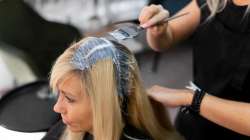Dyeing or colouring your hair during pregnancy might affect the unborn baby; know more
Pregnant women must take safety precautions when dyeing their hair, such as performing a patch test first to avoid allergic reactions.

Pregnancy is definitely good news. Accompanied by numerous concerns, expecting mothers must take safety precautions to prevent any problems during pregnancy; one such common yet unknown example is dying or colouring one's hair. A recent study published in 2021 showed that low birth weight babies are more common in those who dyed their hair in the third trimester of pregnancy.
Experts advise avoiding buying hair dyes from unidentified or unbranded vendors, as they may not have the specified ingredients written explicitly and may contain dangerous compounds that haven't undergone the required safety and quality control inspections.
It is also suggested to perform a patch test first.
It is advised that expectant mothers should dye their hair after the first 12 weeks of pregnancy, as the dye is most likely to enter the mother's bloodstream and, consequently, could get to the unborn child.
Hair dyeing is thought to be safe during pregnancy, especially in the second and third trimesters. However, women should avoid getting their hair coloured during the first trimester, as it is a time of significant growth and development for the foetus.
However, it is recommended to wait until the baby's organs have developed to ensure the safe use of hair dyes. A room with good ventilation is ideal for dying hair. This lessens the likelihood of inhaling any dye-related vapours.
It is recommended to apply colour dye to individual hair strands to prevent the scalp or bloodstream from being exposed to chemicals. Alternatively, use semi-permanent, all-natural vegetable dyes like henna.
To reduce the risk of experiencing any unexpected reactions, stick with the hair colour previously used.
Avoid using hair dyes if you have any abrasions or injuries over your scalp. Pregnant women should also refrain from using hair dyes frequently.
Wear gloves when dyeing your own hair; test the dye on a small section to see if you have any allergic reactions; carefully read the directions; and not leave the chemical on your hair longer than is necessary. After applying the dye, thoroughly rinse your hair.